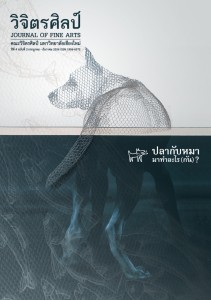การศึกษารูปแบบและกำหนดอายุเวลาเจดีย์ประธาน กู่พระเจ้า และกู่กลางน้ำ วัดเกาะกลาง อำเภอป่าซาง จังหวัดลำพูน
Main Article Content
Abstract
การกำหนดอายุเวลาของกู่พระเจ้าน่าจะสร้างขึ้นในราวรัชสมัยพระเมืองแก้ว(พุทธศักราช 2038 – 2069) หรือประมาณกลางพุทธศตวรรษที่ 21 ดังพิจารณาได้จากการก่อซุ้มโค้งที่ทะลุกันทั้ง 4 ด้านเป็นลักษณะเดียวกับกู่พระเจ้าแก่นจันทน์วัดมหาโพธาราม (วัดเจ็ดยอด) จังหวัดเชียงใหม่ สร้างขึ้นเมื่อประมาณพุทธศักราช 2053 ตามอายุเวลาที่ระบุไว้ในชินกาลมาลีปกรณ์ซึ่งตรงกับรัชสมัยพระเมืองแก้ว
เจดีย์กลางน้ำสันนิษฐานว่าสร้างขึ้นในช่วงประมาณกลางพุทธศตวรรษที่ 21 โดยพิจารณาจากลักษณะการผสมผสานกันของรูปแบบทางสถาปัตยกรรมระหว่างเจดีย์ห้ายอด ในลักษณะเดียวกับเจดีย์ประธานของวัดเกาะกลางสมัยแรกและเจดีย์เชียงยันในวัดพระธาตุหริภุญชัย กับรูปแบบก่อเรือนธาตุเป็นซุ้มโค้งมีลักษณะโปร่งทะลุทั้ง 4 ด้านใกล้เคียงกันกับกู่พระเจ้าของวัดเกาะกลางและกู่พระเจ้าแก่นจันทน์ในวัดมหาโพธาราม การสร้างกู่ที่มีน้ำล้อมรอบยังสะท้อนให้เห็นถึงคติจักรวาลในล้านนาผ่านสถาปัตยกรรม กล่าวคือ กู่เป็นสัญลักษณ์ของเขาพระสุเมรุที่ล้อมรอบด้วยมหานทีสีทันดร
The Study on the Form and Chronology of the Main Stupa, Ku Pra Chao and Ku Klang Num, of Wat Koh Klang, Pa Sang District, Lamphun Province.
This article presents the new findings from the study on the form and chronology of the main stupa, ‘Ku’ (mandapa) Pra Chao and Ku Klang Nam, Pa Sang District, Lamphun Province. Conventionally, academics analyzed and identified that the main stupa were from around 19th Buddhist century because their form and architectural style were like those in Lan Na culture which had been influenced by Burmese-Pagan culture. However, the study leads to the findings that these the main stupa of Wat Koh Klang should be from 21st Buddhist century and had been built and renovated. The original construction took place in the reign of King Tilokaraja (1984 - 2030 B.E.) of Lan Na Kingdom. The style of the main pagoda was influenced by the form of Chiang Yan stupa of Wat Pra That Haribunjaya, Lamphun District. This stupa is a five-peaked one the style of which was inspired by the five-peaked stupa in Mahabodhi Temple, Bodh Gaya. The renovation was carried out in the reign of King Yod Chiang Rai (2030 - 2038 B.E.). The bell-shaped form of the main stupa was changed to Ceylonese style, which reflects the influences from Singhalese Buddhism.
As for the chronology, Ku Phra Chao is assumed to be built in the reign of King Mueng Kaeo (2038 - 2069 B.E.) or around the middle of 19th Buddhist century because the pagoda has an arch on each of its four cardinal points, which are connected to each other, which is like the style of Ku Pra Chao Kaen Chan of Wat Maha Bodharama (Ched Yod) in Chiang Mai Province, which was built in 2053 B.E., as mentioned in Chinakalamalipakorn Doctrine, which is in the reign of King Mueng Kaew.
As for Ku Klang Num Pagoda, it is assumed to be built in mid 21st Buddhist century because its style is the mixture between the five-peaked stupa as the old principle stupa of Wat Koh Klang, and Chiang Yan stupa, which consists of an arch on each of its four cardinal points, which are connected to each other. This style is like the styles of Ku Phra Chao from Wat Koh Klang and Ku Phra Chao Kaen Chan. The composition of this ‘Ku’ (mandapa), which is encompassed by water, reflects the Lan Na concept of the universe through the architecture. The mandapa symbolizes Mount Meru and the water surrounding the pagoda symbolizes Maha Nathee Seethandorn or the great ocean that surrounds Mount Meru, the Centre of the Universe.


